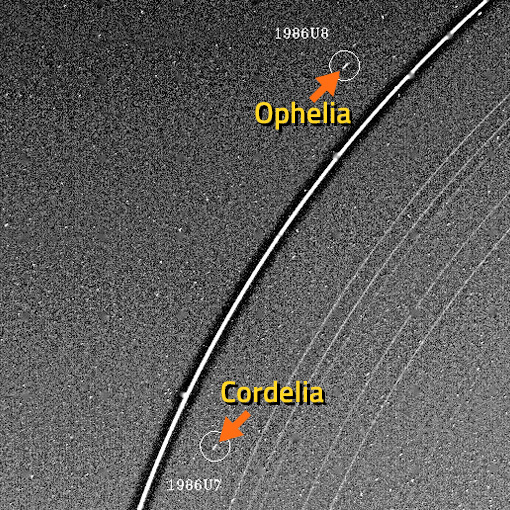Ophelia, a moon of Uranus

Voyager 2's discovery image of the moons Cordelia (1986U7) and Ophelia (1986U8) from 21st January 1986. Image credit: NASA/JPL
33,430 miles
27 miles
Ophelia is one of the 27 moons of Uranus. It is the second closest moon to orbit the planet, orbiting at an average distance of 53,800 kilometres (33,430 miles). Ophelia has a diameter of 43 kilometres (27 miles) and takes only 9 hours to complete an orbit of the planet.
Ophelia is classed as an inner regular prograde moon of Uranus. It travels around the planet in the same direction of the planet's rotation and is believed to have formed from materials spinning around the planet.
Ophelia and its nearby neighbour Cordelia are referred to as shepherd moons. Shepherd moons are moons that exist on either side of a planet's ring, holding the materials of that ring in place and preventing them from escaping.
Ophelia and Cordelia are shepherd moons of Uranus' brightest ring, known as its ε ring or Epsilon ring. Ophelia orbits on the outer side of the ring while Cordelia orbits on its inner side.

In William Shakespeare's tragic play, Hamlet (1599 - 1601), Ophelia is the daughter of Polonius, a scheming advisor to Claudius, the King of Denmark. She is also in love with Prince Hamlet, the son of the former King of Denmark, King Hamlet. Prince Hamlet begins behaving erratically after discovering that Claudius had killed his father, and Polonius persuades Ophelia to end their relationship. Hamlet later kills Polonius, Ophelia's father, mistaking him for somebody else. Ophelia, unable to deal with the end of her relationship with Hamlet and death of her father, drowns herself.
All moons of Uranus are named after characters in plays by William Shakepeare or a poem by Alexander Pope. Ophelia is the only moon of Uranus to be named after a character in the play Hamlet.
The plot for Disney's movie The Lion King is inspired by Hamlet.





